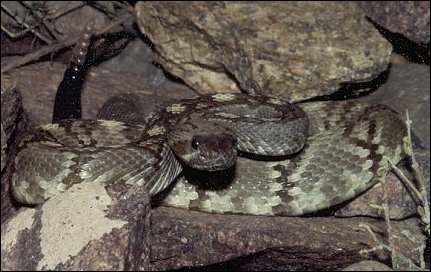
Many people would really rather not think about snakes—as a result, they don't know what they're missing. Even many of those who do consider snakes tend to do so through a haze of prejudice rather than in the bright light of knowledge.
Contrary to popular lore, most snakes are harmless, and those few kinds that are poisonous are not out to cleanse the world of humans—wasting valuable poison that could be used to obtain food is not a snake's idea of good fun. Rather, it's an act of self defense. The early American colonists knew this, and a popular early symbol was the rattlesnake and the words, "Don't tread on me."
Among the tools of the rattlesnake are paired facial pits, uniting them
with other pit vipers such as copperheads and water moccasins. These depressions
perceive infrared radiation—heat, that is—somewhat as eyes perceive light
radiation. Although apparently not possessing the acuity of eyes, they do ease the task
of nighttime hunting, revealing the presence, size, and distance of warm blooded prey.

Contributor: Arthur H. Harris, Laboratory for Environmental Biology, Centennial Museum, University of Texas at El Paso.
Desert Diary is a joint production of the Centennial Museum and KTEP National Public Radio at the University of Texas at El Paso.

Black-tailed Rattlesnake (Crotalus molossus). The pit is clearly visible diagonally below the eye, about half way between eye and mouthline. Photograph by A.H. Harris.
Degenhardt, W. G., C. W. Painter, and A. H. Price. 1996. Amphibians and reptiles of New Mexico. University of New Mexico Press, Albuquerque. 430 pp.